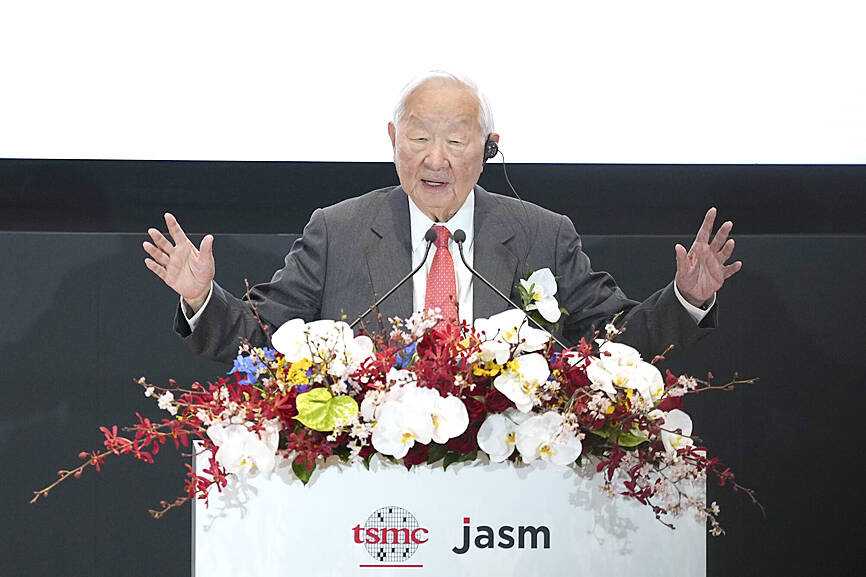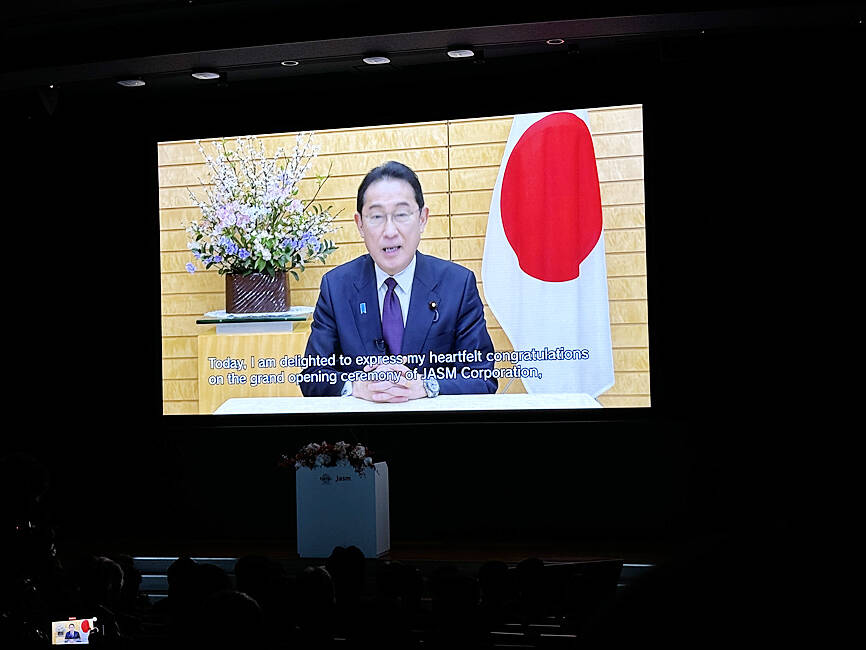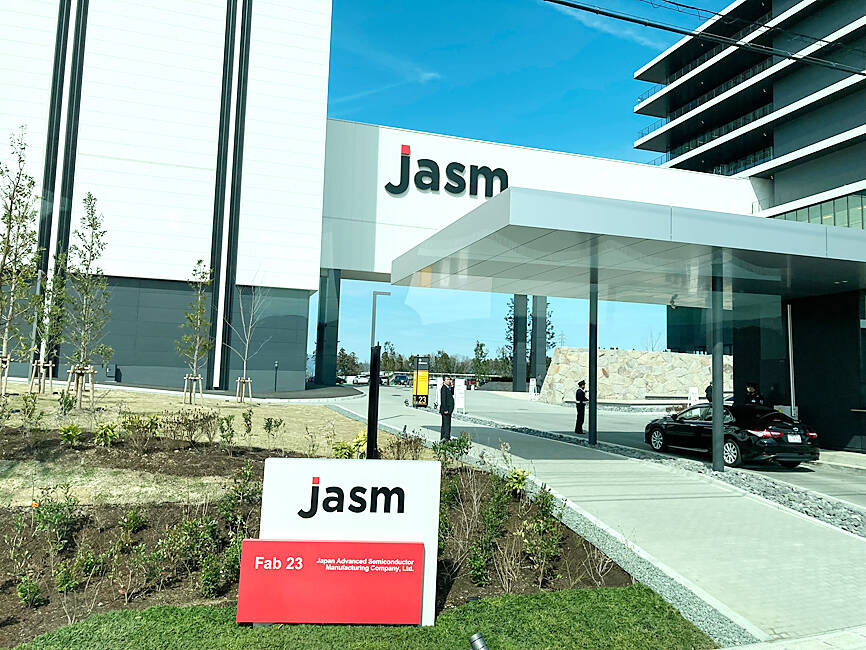Taiwan Semiconductor Manufacturing Co (TSMC, 台積電) yesterday held an opening ceremony for its first chip manufacturing fab in Kumamoto, Japan, which it hopes will improve chip supply resilience and help Japan usher in a semiconductor renaissance.
The Kumamoto fab is slated to enter volume production in the fourth quarter of this year.
The Japanese government said it would extend its financial support of the project to include the construction of a second factory, as TSMC’s investment is crucial to its efforts to revive its semiconductor industry.

Photo: Bloomberg
The Kumamoto fab is owned by a joint venture, Japan Advanced Semiconductor Manufacturing Inc (JASM), which is majority-owned by TSMC. Other partners include Sony Corp and Denso Corp. Toyota Motor Corp joined the venture early this month.
The second fab would use cutting-edge 6-nanometer technology to produce advanced chips to meet growing demand for artificial intelligence (AI) chips, and those used in autonomous vehicles.
“The production of advanced logic semiconductors at JASM is a significant step in both our country’s semiconductor industry and user industries,” Japanese Prime Minister Fumio Kishida said in a prerecorded video during the opening ceremony.

Photo: CNA
The Japanese government has implemented unprecedented support for the development of a domestic manufacturing base for advanced semiconductors, Kishida said.
“As a government, based on the Domestic Investment Promotion Package formulated in December last year, we will continue to swiftly implement support measures such as budget, tax system and regulatory reform,” Kishida said.
The Japanese government has said that it plans to offer about ¥1.2 trillion (US$7.97 billion) in subsidies for the two Kumamoto fabs.

Photo: Lisa Wang, Taipei Times
The construction of the Kumamoto factory went surprisingly well, as it took only one-and-a-half years rather than the 10 years it usually takes for a ¥1 trillion project like this one, Kumamoto Prefecture Governor Ikuo Kabashima said during the ceremony.
During a speech, TSMC founder Morris Chang (張忠謀) said the event reminded him of his first trip to Japan 56 years ago, while he was serving as an integrated circuits executive at Texas Instruments Inc.
He was there in 1968 to talk with Sony cofounder Akio Morita about starting a joint venture, Chang said.
Morita told him he would be pleasantly surprised about the yield he would achieve in Japan, he said.
That prediction came true, and at its height, Texas Instruments operated three semiconductor factories in Japan, he said.
Fifty years after his conversation with Morita, he is again waiting to see if he “will be pleasantly surprised by the yield,” Chang said.
It would be harder this time, because TSMC has a good yield in Taiwan, but he still has high hopes for JASM, he said.
The new JASM fab would “improve the resilience of the chip supply for Japan and for the world,” Chang said. “It will also, I hope and I believe, start a renaissance of semiconductor manufacturing in Japan.”
Semiconductors will be “very much-needed in the future,” driven by demand for AI applications, he said.
AI chip demand would be enormous, requiring tens of thousands wafers and 10 fabs, he said.

STILL COMMITTED: The US opposes any forced change to the ‘status quo’ in the Strait, but also does not seek conflict, US Secretary of State Marco Rubio said US President Donald Trump’s administration released US$5.3 billion in previously frozen foreign aid, including US$870 million in security exemptions for programs in Taiwan, a list of exemptions reviewed by Reuters showed. Trump ordered a 90-day pause on foreign aid shortly after taking office on Jan. 20, halting funding for everything from programs that fight starvation and deadly diseases to providing shelters for millions of displaced people across the globe. US Secretary of State Marco Rubio, who has said that all foreign assistance must align with Trump’s “America First” priorities, issued waivers late last month on military aid to Israel and Egypt, the

France’s nuclear-powered aircraft carrier and accompanying warships were in the Philippines yesterday after holding combat drills with Philippine forces in the disputed South China Sea in a show of firepower that would likely antagonize China. The Charles de Gaulle on Friday docked at Subic Bay, a former US naval base northwest of Manila, for a break after more than two months of deployment in the Indo-Pacific region. The French carrier engaged with security allies for contingency readiness and to promote regional security, including with Philippine forces, navy ships and fighter jets. They held anti-submarine warfare drills and aerial combat training on Friday in

COMBAT READINESS: The military is reviewing weaponry, personnel resources, and mobilization and recovery forces to adjust defense strategies, the defense minister said The military has released a photograph of Minister of National Defense Wellington Koo (顧立雄) appearing to sit beside a US general during the annual Han Kuang military exercises on Friday last week in a historic first. In the photo, Koo, who was presiding over the drills with high-level officers, appears to be sitting next to US Marine Corps Major General Jay Bargeron, the director of strategic planning and policy of the US Indo-Pacific Command, although only Bargeron’s name tag is visible in the seat as “J5 Maj General.” It is the first time the military has released a photo of an active

CHANGE OF MIND: The Chinese crew at first showed a willingness to cooperate, but later regretted that when the ship arrived at the port and refused to enter Togolese Republic-registered Chinese freighter Hong Tai (宏泰號) and its crew have been detained on suspicion of deliberately damaging a submarine cable connecting Taiwan proper and Penghu County, the Coast Guard Administration said in a statement yesterday. The case would be subject to a “national security-level investigation” by the Tainan District Prosecutors’ Office, it added. The administration said that it had been monitoring the ship since 7:10pm on Saturday when it appeared to be loitering in waters about 6 nautical miles (11km) northwest of Tainan’s Chiang Chun Fishing Port, adding that the ship’s location was about 0.5 nautical miles north of the No.